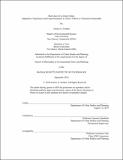Red lines for a green china : adaptation, negotiation and experimentation in China's efforts to transform sustainably
Author(s)
Gordon, Jessica A.(Jessica Alexandra)
Download1139710484-MIT.pdf (6.441Mb)
Alternative title
Adaptation, negotiation and experimentation in China's efforts to transform sustainably
Other Contributors
Massachusetts Institute of Technology. Department of Urban Studies and Planning.
Advisor
Lawrence Susskind.
Terms of use
Metadata
Show full item recordAbstract
After years of rapid economic growth and unbridled urbanization, China is now attempting to transition to an "ecological civilization," the nation's term for sustainable development. A foundational element of China's approach is the development and enforcement of "ecological conservation red lines" (ERLs). As the most comprehensive conservation plan in China's history, for up to 35% of its territory, ERLs define strictly controlled boundaries for ecosystem services and ecologically sensitive areas in order to safeguard natural resources and human health and to address climate risks. Globally, this is the largest effort ever undertaken to plan land uses across geographic scales based on the optimization of ecosystem services. Based on extensive fieldwork and the application of multiple qualitative research and analysis methods, this dissertation is the first comprehensive study of the politics of the ERL. It examines the development of the ERL at the national level and within two localities to address two puzzles: (1) How and why did China create the world's most comprehensive ecosystem-based land planning strategy? (2) How and why would China which is applying top-down command and control environmental regulation, and is increasingly politically centralized, be able to support local variation? The ERL is an integrated science and practice policy model that produced a paradigmatic idea which changes the conceptualization of land use planning in China. The ERL process combines a historical adaptive "guerilla policy style," with a more recent command and control environmental regulation in which targets are set by the central government for local implementation. This apparent contradiction in the ERL's design as dynamic with binding targets has produced an ERL process that was more adaptive, negotiated and flexible than expected. The main determinants of the shape and size of the ERL in each locality were political economy, existing levels of environmental quality, ongoing planning processes, and long-standing institutional dynamics. The ERL outcome has been shaped primarily by interactions among existing institutions in the face of political, economic and moral incentives as understood by local officials. This analysis suggests advances in future studies of institutional change, especially in regards to sustainable transitions.
Description
This electronic version was submitted by the student author. The certified thesis is available in the Institute Archives and Special Collections. Thesis: Ph. D., Massachusetts Institute of Technology, Department of Urban Studies and Planning, 2019 Cataloged from student-submitted PDF version of thesis. Includes bibliographical references (pages 173-186).
Date issued
2019Department
Massachusetts Institute of Technology. Department of Urban Studies and PlanningPublisher
Massachusetts Institute of Technology
Keywords
Urban Studies and Planning.